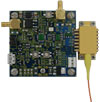



|
Big Photonics Advances Build and Power Big Telescopes
For astronomers, bigger is better: In general, the scientific value of a telescope scales to the fourth power of its diameter. So, doubling the size boosts scientific worth 16 times – assuming no limiting factors. Given that, good times loom. Thanks to photonics innovations and other advances, over the next decade three big telescope projects should come on line. Their primary mirrors range from 25 to nearly 40 m. The two largest current telescopes are about 10 m.
|
|
|
|

Space Lasers Set to Protect Earth, Project Data
From obliterating asteroids to nudging space trash, lasers in space are becoming every bit as futuristic as they sound. Lasers in space have long been a science-fiction writer’s delight, but with current projects such as LightForce and DE-STAR on the horizon, reality could become every bit as fantastic as fiction.
|
|
|
|

CCD Sensors Tailored to Space Applications
Designing image sensors for the ESA’s Euclid mission demonstrates the importance of customization for specialty uses and harsh environments. Adapting commercial electronic parts for space applications usually consists of little more than the addition of screening tests and environmental qualifications. But customizing image sensors from the design through to manufacture can optimize the performance of these devices for both the application and the space environment.
|
|
|
|

Amplitude-Modulated Sensors Could Save Pilots from Wire Hazards
AM scanning laser rangefinder sensors could make less costly, lighter-weight systems for helicopter-mounted wire-warning systems. Wires represent a significant hazard for low-flying helicopters: Collisions with unobserved wire obstacles can result in helicopter or wire damage, or even injuries or fatalities. Because wires are long, thin objects, they may be difficult to detect against various backgrounds.
|
|
|
|

Dual- and Triple-Band AR Coatings Enhance IR Systems
Dual-band IR camera systems allow the 3- to 5-µm and 8- to 12-µm spectral regions to be viewed and compared. They also improve visibility at sunrise or sunset, and help distinguish between targets and decoys. As dual-band third-generation FLIR systems progress, new coatings help these systems perform better. This article will show theoretical and measured designs for ZnSe, ZnS, Ge and IG-6 substrates as well as demonstrated triple-band AR coatings with additional transmittance at 1.06 µm.
|
|
|
|

Silica-Based Fiber Boosts Broad-Spectrum Spectroscopy
In spectroscopy, broad-optical-spectrum fibers optimize the collection and analysis of information. A variety of spectroscopic applications require light transmission over a broad spectrum. Optical fiber with a broad optical spectrum can transmit a wide range of wavelengths with relative uniformity across the wavelength range. This is particularly advantageous in spectroscopic applications because it expands the measurement range and sensitivity of the device.
|
|
|
|





|
T165 Laser Pulser
Highland Technology, Inc.
The T165 Laser Pulser incorporates an edge triggered pulse generator with 150 picoseconds nominal rise and fall times into a butterfly packaged laser.
More info >>
|
|
 |

|
Owl-IR Fixed-Focus Lenses
LightWorks Optical Systems
LightWorks Optical Systems Inc. introduces the Owl-IR line, its first commercially available longwave IR F1.0 fixed-focus objective lenses.
More info >>
|
|
 |

|
Littrow Dispersion Prisms
Precision Glass & Optics
Precision Glass & Optics has released a line of Littrow dispersion prisms for laser cavities and other optical systems, suitable for applications where lasing must be limited to a specific
wavelength.
More info >>
|
|
 |
|
 |

|

|


Follow Photonics Media on Facebook and Twitter
|
 

|
|

sponsor
 |

sponsor
 |


sponsor
 |

sponsor
 |

|